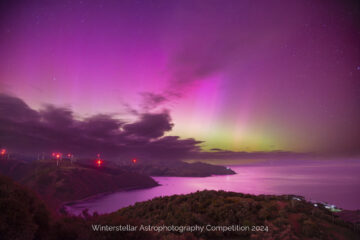Winterstellar are delighted to announce Tāhuna Glenorchy as the first Winterstellar Astronomical Site (WAS)
The Winterstellar Astronomical Site program was launched in August 2024 to recognise those special places in Otago with exceptional dark skies, and strong support from their community and local authority to protect and preserve this important natural resource for future generations.
Winterstellar CEO Andy Davey says the Tāhuna Glenorchy site ticked all these boxes and more.
“It is one of Aotearoa/New Zealand’s very special star gazing locations. The central regions of the Milky Way, the Magellanic Clouds, all rise high in the pristine Glenorchy skies, and its southerly location provides a wonderful and regular view of the Aurora Australis”.
This recognition acknowledges the wonderful job the Glenorchy team have done in putting together a compelling application for international Dark Sky Sanctuary status. As a first step in achieving international Dark Sky Place status the WAS program is designed to assist and bring together interested local community groups.
Tāhuna Glenorchy Dark Skies Project Chair Leslie Van Gelder says they feel so honoured to be the first of the Winterstellar Astronomical Sites.
“We especially love the approach Winterstellar are taking in encouraging community groups in dark and starry places to come together, not only to protect our own sites, but ultimately to work as a team in protecting as much of our incredible region as we can.”

The Winterstellar Astronomical Site Program
A core objective of Winterstellar is to protect the pristine Otago night skies from the ever growing threat of light pollution. Winterstellar believe there are two key pillars in achieving effective dark sky protection. The first being the buy in and support of local communities and the second being the willingness of local government to encourage and implement effective lighting provisions.
Ideally the “Gold Standard” for achieving protected night skies is through Dark Sky International (DSI) recognition. This requires effective lighting management plans, policy protection, and public outreach. However achieving DSI accreditation is neither easy nor guaranteed and can be extremely time-consuming. Recent DSI applications in Glenorchy, Naseby, and Gibbston have taken multiple years and hundreds of hours of work.
Winterstellar CEO Andy Davey says they recognised this scale of investment can be unattainable for many smaller communities who, ironically, are often under some of the darkest skies in the country.
“We felt that if we did not act or only focused on DSI recognition for areas that can afford it, many regions who currently enjoy breathtaking skies may soon lose them to developments with inadequate and poor lighting plans.
“Light pollution travels far with no bounds, and as we lose areas with pristine skies, we inadvertently eliminate potential future DSI-appropriate sites. Therefore we proposed our own Winterstellar Astronomical Site (WAS) recognition program.”
Initiated in 2024 this Otago-wide collaboration in Dark Skies supports interested communities with the sharing and pooling of knowledge and thus serves as an achievable “fist step” towards the ultimate goal of DSI recognition. To date, Glenorchy, Naseby, Bannockburn, Lake Hawea, Cardrona, Gibbston and Lauder are participating in these efforts.
Whilst the WAS application process is light in touch and designed to be simple, collaborative and quick, the program is robustly accredited by experts. Winterstellar have made this possible due to the broad and deep experience in astronomy, dark sky protection, policy, education, out reach and local knowledge of it’s Board members.
If your community or group are interested in pursuing an official Winterstellar Astronomical Site recognition you are encouraged to contact Andy Davey, Winterstellar CEO by the following email: andy@winterstellar.com


